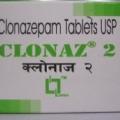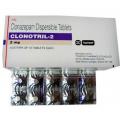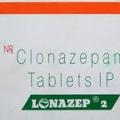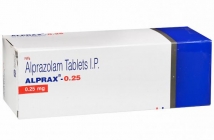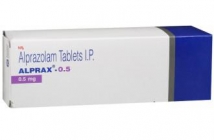Home / Categories / PETRIL-2MG
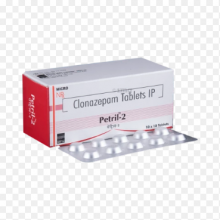
PETRIL-2MG
(10)
CLONAZEPAM-2MG
BENZODIAZEPINES
MICRO LABS LIMITED
Product Details
Clonazepam
Action
Indications
Contraindications
Route/Dosage
Interactions
Lab Test Interferences
Adverse Reactions
PrecautionsPatient Care Considerations
Administration/Storage
Assessment/Interventions
Patient/Family Education
(kloe-NAY-ze-pam)Klonopin,  RivotrilClass: Anticonvulsant/Benzodiazepine
RivotrilClass: Anticonvulsant/Benzodiazepine
 Action Potentiates action of GABA, inhibitory neurotransmitter, resulting in increased neuronal inhibition and CNS depression, especially in limbic system and reticular formation.
Action Potentiates action of GABA, inhibitory neurotransmitter, resulting in increased neuronal inhibition and CNS depression, especially in limbic system and reticular formation.
 Indications Treatment of Lennox-Gastaut syndrome; management of akinetic and myoclonic seizures and absence seizures unresponsive to succinimides. Unlabeled use(s): Treatment of restless legs syndrome, parkinsonian dysarthria, acute manic episodes of bipolar affective disorder, multifocal tic disorders and neuralgias; adjunctive therapy for schizophrenia.
Indications Treatment of Lennox-Gastaut syndrome; management of akinetic and myoclonic seizures and absence seizures unresponsive to succinimides. Unlabeled use(s): Treatment of restless legs syndrome, parkinsonian dysarthria, acute manic episodes of bipolar affective disorder, multifocal tic disorders and neuralgias; adjunctive therapy for schizophrenia.
 Contraindications Hypersensitivity to benzodiazepines; psychoses; acute narrow-angle glaucoma; significant liver disease; shock; coma; acute alcohol intoxication.
Contraindications Hypersensitivity to benzodiazepines; psychoses; acute narrow-angle glaucoma; significant liver disease; shock; coma; acute alcohol intoxication.
 Route/Dosage
Route/Dosage
ADULTS: Initial dose: PO 1.5 mg/day in 3 divided doses. Increase by 0.5–1 mg q 3 days until seizures are adequately controlled (maximum 20 mg/day). INFANTS & CHILDREN (£ 10 yr Or 30 Kg): Initial dose: PO 0.01–0.03 mg/kg/day in 2–3 divided doses. Increase by 0.25–0.5 mg q 3 days until maintenance dose of 0.1–0.2 mg/kg has been reached.
 Interactions
Interactions
Alcohol and CNS depressants: May cause additive CNS depressant effects. Cimetidine, oral contraceptives, disulfiram: May cause effects of clonazepam to increase, with excessive sedation and impaired psychomotor function. Digoxin: May increase serum digoxin concentrations. Omeprazole: May increase Theophyllines: May antagonize sedative effects.
 Lab Test Interferences None well documented.
Lab Test Interferences None well documented.
 Adverse Reactions
Adverse Reactions
CV: Cardiovascular collapse; hypotension; phlebitis or thrombosis at intravenous sites. CNS: Drowsiness; confusion; ataxia; dizziness; lethargy; fatigue; apathy; memory impairment; disorientation; anterograde amnesia; restlessness; headache; slurred speech; aphonia; stupor; coma; euphoria; irritability; vivid dreams; psychomotor retardation; paradoxic reactions (eg, anger, hostility, mania, insomnia, muscle spasms). DERM: Rash. EENT: Visual and auditory disturbances; depressed hearing. GI: Constipation; diarrhea; dry mouth; coated tongue; excessive salivation; nausea; anorexia; vomiting. GU: Dysuria; enuresis; nocturia; urinary retention. HEMA: Blood dyscrasias including agranulocytosis; anemia; thrombocytopenia; leukopenia; neutropenia. HEPA: Hepatic dysfunction, including hepatitis and jaundice; elevated LDH, ALT, AST and alkaline phosphatase. OTHER: Dependence/withdrawal syndrome (eg, confusion, abnormal perception of movement, depersonalization, muscle twitching, psychosis, paranoid delusions, seizures).
 Precautions
Precautions
Pregnancy: Safety not established. Avoid drug, especially during first trimester, because of possible increased risk of congenital malformation. Not recommended during labor and delivery. Lactation: Excreted in breast milk. Children: Initial dose should be small and gradually increased. Longterm use may cause adverse effects such as possibly delayed mental or physical development. Elderly or debilitated patients: Initial dose should be small and gradually increased. Give drug with extreme care to elderly or very ill patients with limited respiratory reserve. Psychiatric disorders: Not intended for use in patients with primary depressive disorder, psychosis or disorders in which anxiety is not prominent. Renal or hepatic impairment: Use drug with caution to avoid accumulation. Seizure: In patients with multiple seizure types, drug may increase incidence or precipitate onset of grand mal seizures. Suicide: Use drug with caution in patients with suicidal tendencies; do not allow patient access to large quantities.
PATIENT CARE CONSIDERATIONS
 Administration/Storage
Administration/Storage
- Give with food or milk to decrease GI upset.
- Do not administer with antacid; give at least 1 hr apart.
- If possible, divide daily dose into three equal doses. If doses are unequal, give largest dose at bedtime.
- Parenteral administration should be reserved primarily for acute states.
- Observe patient for up to 3 hr after parenteral administration.
- Do not inject drug intra-arterially; intra-arterial injection may produce arteriospasm that can lead to gangrene.
- Store at room temperature.
 Assessment/Interventions
Assessment/Interventions
- Obtain patient history, including drug history and any known allergies.
- Assess renal studies: urinalysis, BUN, urine creatinine.
- Assess blood studies (CBC and platelets) prior to and regularly throughout therapy.
- Evaluate hepatic studies: ALT, AST, bilirubin, creatinine, alkaline phosphatase.
- Patient should undergo ophthalmic examination before, during and after therapy.
- Observe for drowsiness, ataxia, confusion, especially in elderly or debilitated patient.
- Drowsiness and dizziness may occur early in therapy; assist with ambulation, use siderails.
- Provide gum, hard candy and frequent sips of water to relieve dry mouth.
- Because of risk of apnea and cardiac arrest, resuscitative facilities should be available.
- Monitor drug levels during therapy. Therapeutic level is 20–80 mg/ml.
- Monitor for blood dyscrasias: observe for fever, sore throat, bruising, rash, jaundice.
- Monitor mental status: mood, sensorium, affect, oversedation, sleep pattern, drowsiness, behavioral changes (especially in children; eg, inattention in school). Report changes to physician.
- Monitor seizure activity and record. Take seizure precautions as needed.
- Abrupt withdrawal, particularly in long-term, high-dose therapy, may cause status epilepticus, vomiting, diarrhea, and sweating; monitor patient carefully.
OVERDOSAGE: SIGNS & SYMPTOMS Somnolence, confusion, diminished reflexes, coma
 Patient/Family Education
Patient/Family Education
- Instruct patient to take drug with food or milk to decrease GI upset.
- Tell patient not to take drug within 1 hr of antacid.
- Instruct patient to keep record of seizure activity and report to physician.
- Encourage patient to carry identification card or Medi-Alert bracelet that indicates diagnosis and drug dosage.
- If patient is child, advise parents to supervise child's play and watch for inattention.
- Caution patient not to stop taking medication abruptly.
- Advise patient to contact physician immediately if serious side effects (eg, changes in mental status) occur.
- Instruct patient to rise slowly or fainting may occur, especially in elderly patients.
- Advise patient to avoid intake of alcoholic beverages or other CNS depressants.
- Advise patient that drug may cause drowsiness and to use caution while driving or performing other tasks requiring mental alertness.
Books@Ovid
Copyright © 2003 Facts and Comparisons
David S. Tatro
A to Z Drug Facts

